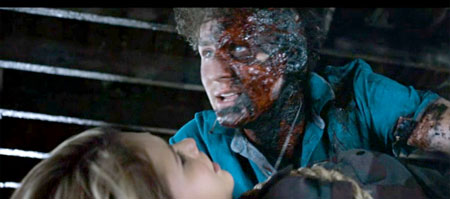Genre parody is a creation that mimics the conventions and style of another work with deliberate exaggeration for comic effect or to create a commentary about the style itself. Parody works through its easily recognizable connections to genre tropes as it twists those tropes to deliver its message. It is similar to pastiche, which is a composition in another artist’s manner, without satirical intent, and will often have similar compositions to the genre its attempting to parody, but is exaggerated or changed in a way that highlights a genres key tropes.
As always, I’ll give an example from my favorite genre here, horror. Horror is such a saturated genre that it has been parodied from practically the beginning of film, as it can also take tropes from horror stories that had existed before then. In modern cinema, a significant portion of the horror genre relies on pastiche. Some of this horror branches out into the realm of parody and that’s where I’ll pull my great example of a horror genre parody from here. One of the most iconic and overdone genres within film, beginning with a group of college or high school youths starting a camping trip, or a get together somewhere in the wilderness, and which devolves into a bloodbath where all the students get separated and slowly die. This specific branch of slasher films really took off in 1980 with the film Friday the 13th as its masked killer Jason snuck his way into nightmares all around the country. This was immediately followed by The Evil Dead (1981) which while not hugely popular at the time has become a cult classic for the genre. With a genre producing such iconic films as these it was only a matter before it began to be parodied in movies such as the Scream and Scary Movie series, and then much more directly represented recently with movies such as The Cabin in the Woods (2012).
Today however, I’ll give my what I believe to be one of the best parodies ever made Tucker and Dale vs Evil (2010)
First the film begins by playing into the traditional cabin slasher opening, however the change in this parody is that it shows both sides of the story. Usually this genre would open up with an ominous warning by some strange man to the group of youths as they encounter some strange omen foretelling of bad things to come. However, within the early scenes here we see that Tucker and Dale are just two hillbillies going on vacation but their rough look leads to misinterpretation.

http://soberingconclusion.com/movies/wp-content/uploads/2011/09/Tucker-Dale-vs-Evil.jpg
The next big element that is parodied is that of the gruesome deaths that are usually part of this genre, and in combination the absolute uselessness of the majority of cast and authority figures in dealing with the supposed “threat”. In many of these camp slasher films, the youths are not only killed by the slasher, but the horrifying accidents which seem impossible. This is exaggerated with Tucker and Dale vs Evil as the kids literally throw themselves onto their own weapons and into wood chippers. This is a clear hyperbole playing on the lack of intelligence shown in many horror genre films as they try to further the plot their culling of side characters through often completely stupid ways.

http://horrorfreaknews.com/wp-content/uploads/2016/03/Tucker-and-Dale-vs-Evil-DI.jpg
Finally we see a parody within the conclusion as the film plays off the “creation of a killer” films that often come out as prequels to many of the major horror films. *spoilers* The final youth left and the “protagonist” on the youth’s side himself becomes the killer who locks away our main heroine, using her as bait to draw out the people he still believes are the real monsters. His disfiguration is an obvious play towards villains such as Jason and Freddy Kruger and the hostage situation he forces allows Dale to become our traditional hero and save the girl in the end.

http://vignette3.wikia.nocookie.net/villains/images/5/5b/Tucker-and-Dale-vs-Evil_2010_0041.jpg/revision/latest?cb=20140628062754
Any horror movie buff should enjoy this comedic genre parody and the fun it pokes at some of the more questionably realistic slasher elements in film, and many of the overused plot elements prevalent within this genre.